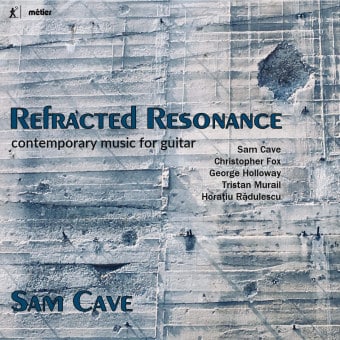Fanfare
Guitarist Sam Cave identifies several strands running through this challenging but infinitely rewarding disc, but perhaps even then one can be added: eloquence. Whether that be of the commentating word (a Julian Bream quote in the booklet around the decaying quality of a plucked instrument, or indeed Cave’s own liner notes), to the works themselves, or to Cave’s playing, it seems to be the very heart of this release.
Little introduction is necessary for the name of Tristan Murail (bom 1947, and perhaps most associated with IRCAM). His Tellur is an investigation of rasgueado guitar strumming from flamenco music on one important level, and more specifically how this can be used to create an ongoing, protracted sound. Other aspects subjected to investigation are contrasting ways of producing attack, harmonics, and the harmonic resonance of chords, amongst others. The performance here is terrific: highly atmospheric, electrically virtuosic, and utterly compelling. I have not heard Rafael Andia’s performance, reviewed positively by Scott Wheeler in Fanfare 14:6, but Stefan Ostersjo, on DB Productions in a disc that also features composers like Donatoni and Carter, is equally persuasive.
The Guitar Sonata No. 1 (2009-11) by George Holloway is dedicated to the present performer. Clouds of harmonics (the composer’s own term) are contrasted with fretted chords and figuration. The two modes of discourse are helpfully illustrated by music examples in the booklet. Microtonal tuning is used to access spectral harmonies. The music itself is extremely challenging technically, but for the listener the impression is one of beauty, a testament perhaps to Cave’s performance. Holloway’s Guitar Sonata No. 2 (2011-14) is a rather calmer affair, intended to invoke the quietness of the mountainous area surrounding the Trinity Church of Gergeti, which sits in the shadow of Mount Kazbegi; there is also a poem that accompanies the work. The progression of the decay of “guide notes,” written on an extra, upper stave, determine the movement of one gesture to the next; the impression is almost of an exiting of clock time.
In between the Holloway sonatas is Christopher Fox’s Chile. The composer is known (in my mind at least) for challenging, acerbic music, but this piece seems rather more approachable, centering the attention on the rhythms of Latin American popular music. True, those rhythms are often interrupted, and Fox uses the contrast of the sounding and the muting of strings as a metaphor for the alternation of freedom and oppression in Chile until the end of Pinochet’s reign in 1980. Written as a companion piece for the ensemble work The Science of Freedom (1990), it offers its own challenges to the listener as well as the performer, given that dislocation and discombobulation lie at Chile’s heart. Cave’s rhythmic virtuosity is remarkable here.
A background of restless digital sounds accompanies Horatiu Radulescu’s Subconscious Wave (1984). Microtonal retunings of strings, intended to match overtones from the harmonic spectrum of the note C, inform this work’s highly individual universe. Seminal in the use of spectral techniques, French-Romanian composer Radulescu offers a masterclass in its effectiveness.
Finally, Sam Cave’s own Refracted Meditations III (2018), part of an unfinished series, is less than three minutes long, but in that time provides an effective summation of the performance techniques investigated throughout this disc.
Fascinating, stimulating fare, beautifully performed and recorded.
@divineartrecordingsgroup
A First Inversion Company
Registered Office:
176-178 Pontefract Road, Cudworth, Barnsley S72 8BE
+44 1226 596703
Fort Worth, TX 76110
+1.682.233.4978



![Listen to the full suite of Marcel Dupré’s Variations Sur un Noël, Op. 20 from Alexander Ffinch’s #Expectations release today! listn.fm/expectations [in bio]](https://scontent-dfw5-2.cdninstagram.com/v/t51.71878-15/587816445_3728293960638394_8983375262174365153_n.jpg?stp=dst-jpg_e35_tt6&_nc_cat=107&ccb=7-5&_nc_sid=18de74&efg=eyJlZmdfdGFnIjoiQ0xJUFMuYmVzdF9pbWFnZV91cmxnZW4uQzMifQ%3D%3D&_nc_ohc=kYbaImPUKuAQ7kNvwFGYoqF&_nc_oc=Adm1vgrRHBxFmyp-8HrFe5i9QpQ_uoGu0q4s--hw_DwyNpi2zILli2GhAmVWbj80XhU&_nc_zt=23&_nc_ht=scontent-dfw5-2.cdninstagram.com&edm=ANo9K5cEAAAA&_nc_gid=ERnCzfAyTSthe3--vSqJqQ&oh=00_AflsDvkShAWm3FzeHqaFJls9mpKCMei7O-oA4GsF7h03aA&oe=69423D3E)

![“the ‘Manteca’ Paraphrase – a rare foray into the two-piano medium but here played double-tracked – exudes a panache of which Dizzy Gillespie would surely have approved.… [a] recital well worth investigating.” —Gramophone Magazine with high praise for Ophelia Gordon's debut release, Kapustin: Between the Lines!](https://scontent-dfw5-3.cdninstagram.com/v/t51.82787-15/598796470_18303255136283342_540941604740887837_n.jpg?stp=dst-jpg_e35_tt6&_nc_cat=108&ccb=7-5&_nc_sid=18de74&efg=eyJlZmdfdGFnIjoiRkVFRC5iZXN0X2ltYWdlX3VybGdlbi5DMyJ9&_nc_ohc=OfdrKYz7Ls4Q7kNvwFRKGEI&_nc_oc=AdnFjdz_-U7KryBH_R_sozlTW8VZHgaJvaNvrLM_8BH71geHCVtdILoosmVJRwuqtRE&_nc_zt=23&_nc_ht=scontent-dfw5-3.cdninstagram.com&edm=ANo9K5cEAAAA&_nc_gid=ERnCzfAyTSthe3--vSqJqQ&oh=00_Afn2yAkzKVzJsg9kJqYmTWsQaa4BnEvbupnPlWr-snQjPw&oe=694225C4)






